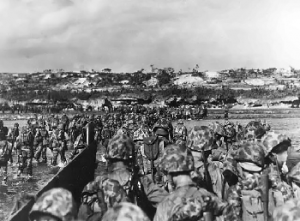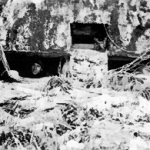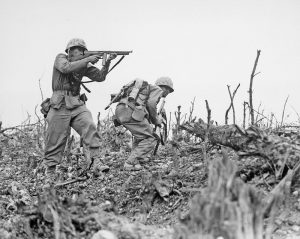 Every battle fought in a war is important, but some battles carried mush more weight, either in it’s strategic importance, or in it’s loss of life. Sometimes, a battle’s importance is due to both, as is the Battle of Okinawa, which was the largest and deadliest campaign in the Pacific Theater of World War II. The atomic bombings of Japan, which ended World War II in the Pacific Theater, were a direct result of battles undertaken on many key Pacific Ocean islands between the United States and its allies, and the Japanese forces. While these battles were bloody and deadly, costing many lives, they were nevertheless, of ultimate importance to the defeat of the Japanese Empire. The Battle of Okinawa, codenamed Operation Iceberg was the deadliest of the war.
Every battle fought in a war is important, but some battles carried mush more weight, either in it’s strategic importance, or in it’s loss of life. Sometimes, a battle’s importance is due to both, as is the Battle of Okinawa, which was the largest and deadliest campaign in the Pacific Theater of World War II. The atomic bombings of Japan, which ended World War II in the Pacific Theater, were a direct result of battles undertaken on many key Pacific Ocean islands between the United States and its allies, and the Japanese forces. While these battles were bloody and deadly, costing many lives, they were nevertheless, of ultimate importance to the defeat of the Japanese Empire. The Battle of Okinawa, codenamed Operation Iceberg was the deadliest of the war.
Following the December 7, 1941 Japanese attack on Pearl Harbor, Hawaii, the United States officially entered World War II. The United States had a score to settle, but at the onset things did not go well for the US. The Japanese kept expanding and conquering in the Pacific and seemed unstoppable. The United States and its allies rallied and were able to start gaining ground at the Battle of Midway in 1942, but it was the Battle of Okinawa that really changed things.
Military leadership realized that, because the Japanese controlled a vast area of the Pacific, taking over the many islands dotting the Pacific would be crucial to victory. They needed bases from which to launch the various operations against Japan, and these islands were perfect for it. American soldiers, sailors, and marines  fought over the next three years, on little islands in places many Americans had never heard of…places like Tarawa, Midway, Saipan, Luzon, and Cape Gloucester. Each battle, brought with it significant bloodshed. The Japanese fought ruthlessly to the end in all cases, refusing to surrender even in the face of obvious defeat. They would rather die than give up, and many did. It was the samurai code of Bushido, in which Japanese soldiers fought to the death because they believed in death before defeat. Slowly, the Allies began to push the Japanese off occupied islands and Japan started to run out of ships, planes, and soldiers as the war continued.
fought over the next three years, on little islands in places many Americans had never heard of…places like Tarawa, Midway, Saipan, Luzon, and Cape Gloucester. Each battle, brought with it significant bloodshed. The Japanese fought ruthlessly to the end in all cases, refusing to surrender even in the face of obvious defeat. They would rather die than give up, and many did. It was the samurai code of Bushido, in which Japanese soldiers fought to the death because they believed in death before defeat. Slowly, the Allies began to push the Japanese off occupied islands and Japan started to run out of ships, planes, and soldiers as the war continued.
As 1944 turned into 1945, the Japanese were pushed back onto what they considered their “home” territory on the Ryukyu Islands, one of which was Okinawa. This island was crucial to the American war strategy, because from there, they could successfully launch bombing raids on the Japanese homeland. On March 24, 1945 the US Navy launched artillery bombings and air raids on the island to weaken the forces located there. Eight days later, hundreds of thousands of soldiers landed on Okinawa’s beaches in what was called Operation Iceberg. Their mission was to capturing or destroy the island’s air bases. The original landing had 287,000 US troops versus 130,000 Japanese soldiers.
The fighting continued for two and a half months. The American soldiers fought in four critical areas of the island with specific strategies…take the eastern coast of the island, followed by the northern part, then take the  outlying islands surrounding Okinawa, and finally defeat the embedded Japanese troops. It all sounded pretty straightforward, but this battle was different. In this battle, the Japanese didn’t engage their enemies right on the beach, like they had in other battles. At Okinawa, they fell back into the jungles of the island to gain what little advantage they could as a defensive force. The Japanese used caves, pillboxes…fortified positions, and the jungle to their advantage. They also resumed a deadly tactic on the seas…kamikaze attacks. Brave pilots loaded their planes with high explosives and crashed into ships, destroying several, including their attached aircraft. Nevertheless, eventually the Allies won and Okinawa still houses an American base to this day.
outlying islands surrounding Okinawa, and finally defeat the embedded Japanese troops. It all sounded pretty straightforward, but this battle was different. In this battle, the Japanese didn’t engage their enemies right on the beach, like they had in other battles. At Okinawa, they fell back into the jungles of the island to gain what little advantage they could as a defensive force. The Japanese used caves, pillboxes…fortified positions, and the jungle to their advantage. They also resumed a deadly tactic on the seas…kamikaze attacks. Brave pilots loaded their planes with high explosives and crashed into ships, destroying several, including their attached aircraft. Nevertheless, eventually the Allies won and Okinawa still houses an American base to this day.


4 Responses to Operation Iceberg